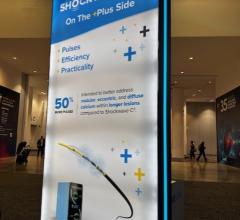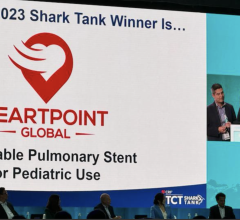
The Teleflex Manta large bore vascular closure device.
November 9, 2021 — Results from the largest randomized trial available comparing different closure device strategies following transcatheter aortic valve replacement (TAVR) found that a plug-based vascular closure technique had a shorter time to hemostasis, but a higher rate of access-site or access-related vascular complications.
Findings were reported at the 2021 Transcatheter Cardiovascular Therapeutics (TCT) annual scientific symposium of the Cardiovascular Research Foundation (CRF). The study was also published simultaneously in Circulation.[1]
TAVR is commonly used for elderly patients with severe aortic stenosis (AS). However, vascular complications after transfemoral TAVR contribute significantly to morbidity and mortality and are commonly related to the arterial access site. Several approved percutaneous vascular closure device (VCD) strategies are available and are being used interchangeably in routine clinical practice.
The CHOICE-CLOSURE trial was an investigator-initiated, multicenter trial that randomized patients with severe symptomatic AS and acceptable transfemoral vascular access to either the pure plug-based MANTA VCD technique or the primary suture-based ProGlide technique. Between June 2020 and June 2021, 516 patients undergoing transfemoral TAVR were enrolled and randomized 1:1 at three German centers. The plug-based strategy was used in 258 patients and 258 patients received the suture-based vascular closure strategy.
The primary endpoint was the rate of access-site or access-related vascular complications according to the Valve Academic Research Consortium (VARC)-2 definition during index hospitalization. The event rate for the plug-based technique was 19.4% compared to 12.0% in the suture-based technique (RR 1.61, 95% CI 1.07-2.44, p=0.029). Secondary endpoints included device failure, time to hemostasis and access-site related bleeding at 30 days. Time to hemostasis was lower with the plug-based technique (80 seconds versus 240 seconds, p<0.001). The 30-day outcomes for access-site or access-related vascular complications, access-site or access-related bleeding and/or VCD failure was 19.8% for the plug-based group compared to 12.8% for the suture-based group (p=0.043).
“With the introduction of large-bore plug-based devices, operators now have an alternative to the classical suture-based technique,” said Mohamed Abdel-Wahab, M.D., Ph.D., professor of interventional cardiology, consultant cardiology and head of department of structural heart disease at the Heart Center Leipzig, University of Leipzig. “However, randomized comparisons of these technique are scarce. Results from CHOICE-CLOSURE indicate that both techniques have infrequent severe complications, with low and comparable mortality and life-threatening bleeding rates. While associated with a shorter time to hemostasis, the plug-based technique did have a significantly higher rate of access-site or access-related vascular complications.”
The study was funded by Helios Kliniken GmbH. Prof. Abdel-Wahab reported consulting fees/honoraria from Boston Scientific and Medtronic
Links to All the TCT 2021 Late-Breaking Clinical Trials


 May 05, 2025
May 05, 2025 








